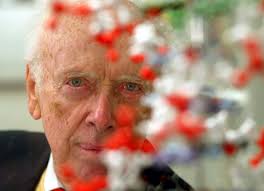 Хотя с момента публикации знаменитой статьи Уотсона и Крика прошло уже много лет, связанные с ней обстоятельства продолжают волновать учёный мир. В 2003 г. отмечался полувековой юбилей статьи, и тогда возник вопрос: рецензировалась ли она? Приведу два письма в редакцию журнала «Nature» (они показывают и то, как менялся процесс отбора, оценивания поступивших статей в этом старейшем и уважаемом издании):
Хотя с момента публикации знаменитой статьи Уотсона и Крика прошло уже много лет, связанные с ней обстоятельства продолжают волновать учёный мир. В 2003 г. отмечался полувековой юбилей статьи, и тогда возник вопрос: рецензировалась ли она? Приведу два письма в редакцию журнала «Nature» (они показывают и то, как менялся процесс отбора, оценивания поступивших статей в этом старейшем и уважаемом издании):
How genius can smooth the road to publication
JOHN MADDOX (now Emeritus Editor, was Editor of Nature during the periods 1966–1973 and 1980–1995)
As Jens Brümmer states, the Watson and Crick paper was not peer-reviewed by Nature. I have two comments on this. First, the Crick and Watson paper could not have been refereed: its correctness is self-evident. No referee working in the field (Linus Pauling?) could have kept his mouth shut once he saw the structure. Second, it would have been entirely consistent with my predecessor L.J.F. Brimble’s way of working that Bragg’s commendation should have counted as a referee’s approval. Brimble, who used to «take luncheon» at the Athenaeum in London most days, preferred to carry a bundle of manuscripts with him in the pocket of his greatcoat and pass them round among his chums «taking coffee» in the drawing-room after lunch. I set up a more systematic way of doing the job when I became editor in April 1966.
An interesting question is how Wilkins and Franklin came to have papers in the same issue. J.T. Randall, the head of physics at King’s College, was a pal of Brimble’s co-editor at the time, A.J.V. Gale, and it is known that Crick sent a copy of his paper to Maurice Wilkins. (He probably sent one to Rosalind Franklin as well.) My guess is that Randall would have called up Gale the minute he heard about Crick’s paper, pleading for equal treatment for King’s. There’s a letter from Wilkins to Crick saying: «Franklin has jumped on the bandwagon — Christ!».
* * *
Nature (12 February 2004)
Was Watson and Crick’s model truly self-evident?
STANLEY SCHER (PO Box 9456, Berkeley, California 94709, USA)
Sir
I am compelled to reply to the comments of Nature’s emeritus editor John Maddox concerning Nature‘s editorial decision not to send the Watson and Crick paper for peer review. Maddox’s retrospective comment «the Crick and Watson paper could not have been refereed: its correctness is self-evident» represents the wisdom of hindsight. To suggest that any model is correct and self-evident on its face leads to acceptance without questioning.
In response to Maddox’s comment that the paper could not have been refereed, several capable reviewers were available — Rosalind Franklin, Maurice Wilkins or Erwin Chargaff, for example. Even Watson and Crick had serious doubts about the correctness of their DNA structure. The 1953 Nature paper expresses self doubt: «previously published X-ray data on deoxyribose nucleic acid are insufficient for a rigorous test of our structure … it must be regarded as unproved until it has been checked against more exact results».
In the F.L. Holmes book «Meselson, Stahl and the Replication of DNA» (Yale Univ. Press, New Haven, 2001), the author notes that Watson «suffered from periodic fears that the structure might be wrong and that he had made an ass of himself. … Watson really did harbor serious doubts about the validity of their structure for DNA, before and after he and Crick published their first paper in Nature».
In a letter dated 12 March 1953 to Max Delbrück at Caltech, Watson states: «The X-ray pattern approximately agrees with the model, but since … we have no photographs of our own … this agreement in no way constitutes a proof of our model. We certainly are a long way from proving its correctness. … In the next day or so Crick and I shall send a note to Nature proposing our structure as a possible model, at the same time emphasizing its provisional nature and the lack of proof in its favor».
 Джеймсу Уотсону сейчас 89 лет. Интересно, избавился ли он от опасений, that the structure might be wrong?
Джеймсу Уотсону сейчас 89 лет. Интересно, избавился ли он от опасений, that the structure might be wrong?
